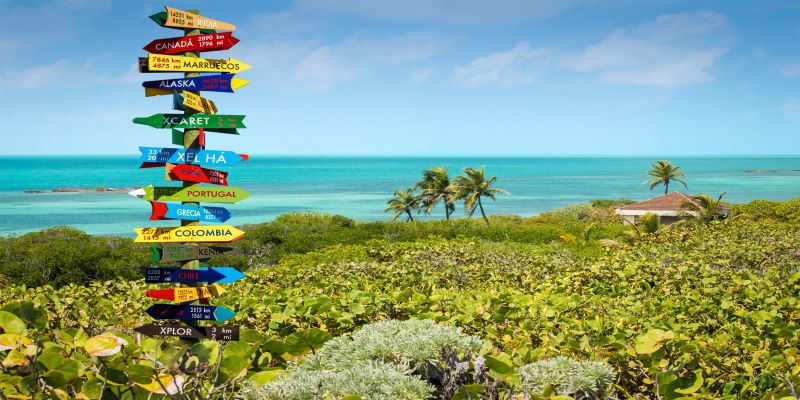In travel, supply chains are inherently complex. We both deal with several million providers of services - including but not limited to hotels, activity providers, transfer providers, rental car providers, restaurants, events and attractions, guide services, airlines, train lines, bus lines, ferries and cruise lines.
In some verticals, this number of service providers has also created a huge network of distributors, consolidators and aggregators.
But how do we now find the best source of products? And should we regard this situation as an unnecessary complexity or as a valuable element of diversity because it allows for a lot of differentiation?

Example: accommodation
Hotel distribution has come a long way since the early days.
In the beginning, things were simple: a travel agent showed their client a leaflet with a few pictures of the destination and the hotels available.
All the client needed to do was to choose the destination and the category, according to budget, get a voucher and off they went.
Behind the scenes, the travel agent acquired the leaflet from a tour operator. The operator contracted hotels to local destination management companies, who in turn contracted the hotels in the location.
Contracts were made by hand and usually an allotment was assigned to each contract, thus preventing overbookings. Bedbanks then appeared. Transhotel and the booking fax, instant confirmation on the hotel without the need of a fixed allotment.
And finally, sending details to customers via email - the internet came with cheap access to technology and connectivity.
From there, the number of options exploded: online travel agencies, bedbanks, DMCs, hotel chains, channel managers, distribution platforms, every player in the supply chain started buying and selling from each other and sometimes repurchasing their own stock from their client and selling it again downstream.
Now anyone could start their hotel distribution business without getting out of bed, competition got even more aggressive and the conversion rates dropped dramatically. And to make things even more complex, the number of available accommodation options exploded with the emergence of vacation rentals.
Then came COVID-19.
Reality of doing business
The global pandemic has forced the industry to focus on their value proposition.
Many hotel distribution companies realised that theirs got lost somewhere along the way. Companies did their "fat-removal procedure" one way or another.
So, in a twisted way, we are going back to the "good ol' days", where each player had its niche and goals and stuck to it.
Technology has changed this game significantly and in doing so, it has also made the landscape more complicated. Technology in hotel distribution is a commodity and it’s how every company applies technology to their specific business, to their value proposition, which will tilt the boat their way instead of the other.
This also means niche markets are still very attractive. The same DMC that was contracting hotels back in the 1960s or 1970s can still have the best contract out there, simply because they have been in business for over 50 years.
Every player has to consider what value they provide to be the best at what they do. Being the best in the business, whatever that business is, will never get old fashioned.
For distribution players, it means there won’t be just one supplier that can give you everything you need. You will need to find flexible sourcing models and technology can help you solve the many associated challenges as highlighted below.
Other travel verticals
The situation in other verticals is not fundamentally different from hotels. Some of them are
easier because there are fewer service providers (e.g. rental cars) but for most of them you have service providers as well as various intermediaries.
In tours and activities, for example, this landscape is still in the process of taking shape. It’s difficult for a distribution company to figure out how to deal with this very fragmented market.
At the same time, this allows for a lot of differentiation, especially in the area of experiences.
Solutions
There are lots of ways to approach the sourcing problem from the distribution side.
The biggest players (e.g. Expedia Group or Booking Holdings) are developing their own sources for each vertical from the ground up and are creating a big competitive advantage by doing so.
Others rely on strong consolidators complemented by specialized niche players who have prices that can compete with the big guys.
In any case, solutions are needed to make any of those approaches work.
Technology components such as a hub save on integration time and can combine the different sourcing options in a smart way.
Payments need to work efficiently cross-border and cross-currency. We need smart ways to solve the various payment risk and cash flow topics involved in making commitments (bookings) way ahead of the service delivery and even across borders and legislations.
And the more fragmented a sourcing strategy becomes, the more we need ways to manage many contracts (we are curious how smart contracts will come into play) and to automate all the corresponding rules regarding payments, booking handling, post-booking processes etc.
A diverse future
We do not think that this complexity will disappear anytime soon. In fact, diversity is not only good, but also for business. It fosters choice, differentiation, and innovation.
We are hoping that the future of travel supply is not all about consolidation.
However, it needs to get easier for everyone to navigate the complexities. Maybe it will be second nature to the next generations?
Whatever way things progress, we are convinced that the future of travel supply should ideally be a decentralized one, and that the various types of technology mentioned above are here to support this.
This will contribute to a better, more democratic and sustainable industry.














